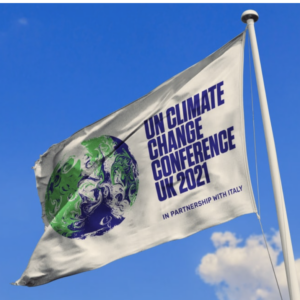COP26 has placed a global eye on how climate change is impacting our world. As many world leaders race the clock on agreeing to a climate deal that all parties can rally behind, there is one critical component summit goers are overlooking. Climate change isn’t just a political agenda item, it’s a human issue. And a pretty large one at that.
Changes in our climate affect every single human being because regardless of our color, class, or nationality, we share the same weather system. A system that those in positions of power have drastically altered through their collective decision to emit greater amounts of carbon into our atmosphere.
The decisions of the few now affect everyone across the world, but in the United States, they disproportionately impact people of color. This is because of the policies, institutions, and systems these same decision-makers have and continue to design to disenfranchise and marginalize people of color from access to basic necessities.
For example, a flood that threatens any of our coastal communities nationwide, how can people pack up and leave without a system of reliable and trustworthy public transportation, public housing, and employment opportunities? And even so, with the racial wealth gap among Whites and nonWhites at its peak (e.g. the median net worth of a White family is 15 times greater than the median net worth of a Black family), where would most families of color get the resources they need to relocate, rent/buy another property, secure other sources of income, and build a new life altogether? Not to mention that those in underserved communities, which typically have larger populations of people of color, are statistically less likely to prepare for and recover from the effects of climate change.
The United States remains a hypersegregated country. White people generally live around other White people, and people of color — inclusive of Black, Hispanic/Latinx, Asian, Middle Eastern, and Indigenous people — live around their group or one another. This is due to deliberate policies of our institutions, including banking, real estate, and our government, that have had a long history of redlining, restrictive covenants, and conscious bias in keeping White people separate from all other groups.
These challenges are further aggravated by the lack of representation of people of color at the local, state, and even at the federal level. Municipal governments that make decisions on behalf of counties and communities generally do not have representation from people of color who are most impacted by the dangers of climate change. Meaning that decision-makers often do not consider their welfare in making decisions, which is why nationwide, places where people of color live lack basic resources — like reliable transportation, well-resourced schools, hospitals, etc. — needed for their communities to thrive.
In addition to lacking basic necessities, communities of color have been relegated to live in environments that policymakers have consciously decided to place numerous environmental traumas, such as toxic waste sites, landfills, incinerators, among others. And these environmental pollutants have been shown to directly impact the health of communities — whether they are Indigenous people on reservations or Black or Hispanic people living in urban environments. Because of this communities of color are exposed to a variety of personal health and material-well being risks.
We cannot understand how climate change disproportionately impacts people of color without talking about systemic racism. Systemic racism (or structural racism) is a description of a reality in the United States that creates disparate outcomes for Black, Indigenous, and people of color (BIPOC) due to the decision-making of our leaders. There are four components of systemic racism: Lack of resources, presence of trauma (as described above), institutional policies, and bias.
Institutional policies describe the decisions and norms created by various levels of public and private actors that have created climate change, including the decision to neglect communities of color with basic resources and deciding to place traumatic environmental factors in their surroundings. Bias describes the conscious and unconscious beliefs held by decision-makers about the humanity of various groups. It determines how our decision-makers distribute taxpayer dollars on policing and incarcerating people of color versus using those same funds to subsidize education, daycares, or healthy food options in those same communities.
While our laws prohibit racial discrimination, science has shown beyond a reasonable doubt that unconscious biases sustain and exacerbate race-based inequality and injustice in our nation. Addressing and breaking bias among our leaders holds the key to innovating and creating solutions to the myriad of challenges posed by systemic racism and climate change. It is conscious and unconscious biases that are held by decision-makers in various corridors of power that determine how they make decisions and who those decisions end up benefiting and harming.
These four interdependent components of systemic racism build the reality of race-based marginalization, exclusion, and violence people experience in our society, which is further compounded by the realities of climate change.
Coming off the heels of COP26, I urge our politicians and representatives in the public sector to understand that climate change isn’t going to go away unless we also start addressing systemic racism. This is no longer just a “political issue” to debate over the dinner table, but a humanitarian one, especially for people of color around the world.

